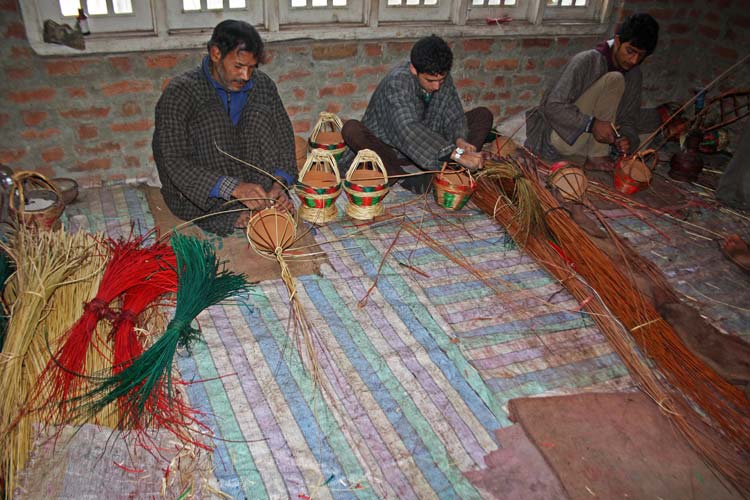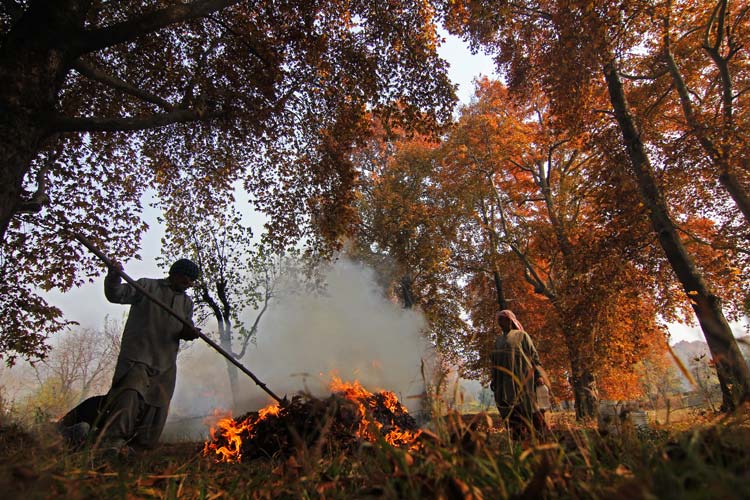Many belts across Kashmir thrive on Kangri making for a living. While most of the artisans are dispersed in clusters, there is a village in South Kashmir, which is entirely into Kangri making. Bilal Handoo visits the village and shares accounts of the village, villagers, and their tryst with the trade.

As autumn is slowly transforming into winter, the pitch and pinch in cold intensity across Kashmir are escalating. No sooner than mercury dips, local markets flood with Kangeris (ember-abode pot) produced in different regions of the Valley. But unlike in other parts, where kangri artisans are confined in limited spaces, an entire Wakai village in south Kashmir’s Kulgam district thrives on kangri making twelve months in a calendar year.
About 70 km from Srinagar, the sun is shining over Wakai (popularly known as OK village). Old mud houses with thatched roofs of the village appear on the scene after travelling 14 km (from Islamabad) and 3 km (from Kulgam) districts respectively. There are least signs of construction in Wakai, unlike neighbouring villages where the construction boom seems to be changing the countryside. Besides being planted with walnut and apple trees, freshwater streams (guarded by poplar trees and pebbles) flow close to recently harvested fields in OK village.
This is where bulk production of kangri offshoots every year, which subsequently make way inside scores of households across the Valley and warm up the chilly moments of people in winter. Some 600 families living in OK village make use of their skilled hands to make kangris, besides preparing raw material for the same.
It is twelve in the noon and villagers are busy with their routine tasks. Some men are placing koundals or earthen bowl-shaped pots (which form the core of kangri) on sidewalks for drying under the naked sun. Female folks are ferrying big wicker baskets containing koundals on their head. On a roadside, an old man with weathered looks and soiled hands is busy lining up koundals. He is Abdul Rehman Kumar, a potter in his mid-sixties. He has been making these pots for more than fifty years now.

Every morning, Kumar and other potters from Wakai collect mud from hilly sides of the village and moisten it on their return. Once embarked on speedy potter’s wheel, potter then make use of his skilled hands to crave out pots from wet mud.
“Earlier we used to make mud utensils as well,” says Fayaz Kumar, 27, a new generation potter from Wakai, “but now we only make koundals.”
As demand for kangeris has surged from the last couple of years in the Valley, as per Kumars, they have shifted their entire focus only on koundal making. They sell a single pot between 5 to 10 rupees. “A single potter can make between 100 to 200 pots a day,” says Fayaz. “This usually fetches a potter anything between 500 to 1000 rupees daily.”
After the earthen pots are moulded, these are sold to the artisans within the village who complete the wickerwork around them. Artisans erect two arms to handle the pot and colour it to give an aesthetically delicate shape.
Landowners in Wakai grow wicker in their paddy fields and later sell it to artisans. In case of demand for wicker soars, artisans then place supply orders from outside the village like from Shalbugh in the Ganderbal district or in other parts of the Valley.
There is one Shaaksaaz Mohalla in OK village which houses 25 families of kangri artisans. They don’t possess any landholdings unlike the rest of the villagers. Dwell in wood and mud houses, separated by peeking mud walls, this part of Wakai gives vibrant community bonding sense. Women on their doorsills are chatting, while kids are playing on dusty pathways. Cemented boilers have been constructed by villagers for boiling raw wicker at a number of places. At a short distance, young women are adding colours to wickers by dipping (a bunch of them) in dye tubs.
Interestingly, people living in Shaaksaaz Mohalla are known as ‘Baandhs’ in common parlance or Kashmiri folk artists. They perform famous ‘Band-e-Pather’ or Kashmiri folk music at cultural events and occasionally for visual or audio mediums.
“Most of us have left performing now,” says Bashir Ahmad Shaakhsaaz, 36, making kangri along with his three brothers in a shabby room of his one storey house. “There are no admirers around now. Besides, occasional calls for performance aren’t enough to run the affairs of the home.”
Bashir’s aged father, Wali-ud-din Shaaksaaz (along with his six grandchildren) is running his hands on kangri in the square of his house under the afternoon sun. This 75-year-old man with a parched face and dark-toned appearance says that in Kashmiri folklore the kanger has occupied a prominent place. But does he know anything about how the making of kanger started in his village?
“What I have heard from my father and grandfather is that some foreigners who visited Kashmir during the Mughal period passed the skill to us,” Wali-ud-din recalls. “My forefathers were doing it and now my children and grandchildren are carrying it forward.”
As per one legend, Kashmiris learnt the use of kangri from the Italians who usually visited the Valley in the summertime during the reigns of Mughal emperors in Kashmir. The use of kangri like device in Italy known as a scaldino makes some conclude that roots of kangri lie in Italy. However, historical data contradicts the claim that kangri has come to Kashmir from Italy, but it is known that it was used in the time of the Mughal Empire.

Wali ud Din and his sons make four types of kangris like other artisans in Wakai. These kangris differ in price tag as well as in customer baseline. The coarsely made kanger with a bigger koundal is called Graes Kanger, which is used by peasants. The finely worked and coloured ones are known as the Khoja Kanger. And then there is a Mahren Kanger, which is specially made for brides. The bridal kanger is not comfortable because of its size, but it is extremely attractive and used essentially for decoration. The fourth kanger made by artisans in Wakai is known as Sur Kanger. It is a small kanger specially made for small children and varies in size.
Although artisans of OK village supply bulk production of Kangris to the Valley markets, at the same time they acknowledge that “their kanger is not the best in business.” The best kanger, they say, is made in Chrar-i-Shrief, the resting place of Sheikh Nur-ud-Din Wali, the patron saint of Kashmiri’s Rishi order. In fact, Sir Walter Lawrence, the author of ‘The Valley of Kashmir’ noted: “Among the most prized of the Chrar-i-Sharif fairings is the pretty painted Kangar”.
Other than Wakai and Chrar-i-Shrief, kangris from Shahabad, Bandipore are also known for their good quality.
Meanwhile, in another weathered household of Shaaksaaz Mohalla, Rafiq Ahmad, a father of five children is making kangris in a dimly lit room. Early March this year, his elder son Tauseef was denied a bank loan as he failed to produce a government employee as his guarantor. “How could we find a government official in our village where till today just one student has reached University level,” says Tauseef, who wanted to give a financial boost to kangri trade by availing a bank loan. “We need government assistance to take this trade to the next level.”
Apart from what artisans claim “state indifference”, the trade of kangri making seems flourishing in Wakai, thanks to winter demands. The neighbouring villagers have also started to run their hands on kangri making after sensing its promising market.
Kangri, which has also been described as a ‘Sheena Maharin’ or the Snow-Queen is smiling over the OK village like a November sun. With the majority of the population indoors making kangris, the village has assumed a quiet look. Artisans spend 18 out of 24 hours in a day to meet the demand at the moment which, as per them, is only surging.
“If any of our relatives pass away at this moment,” says Bashir Shaaksaaz, “we know, we can’t take part in his/her funeral, as kangri making is hardly leaving any time available to us.”















